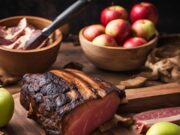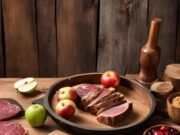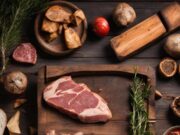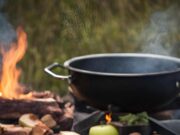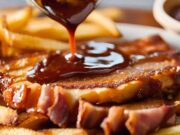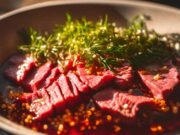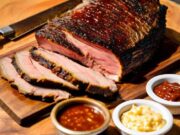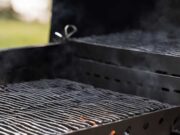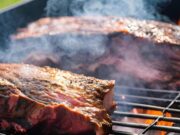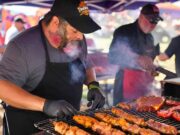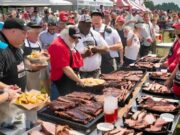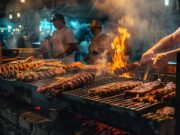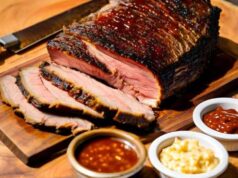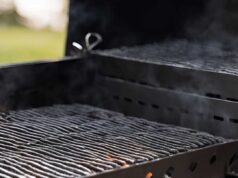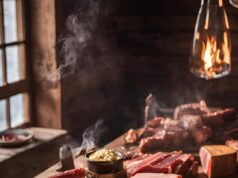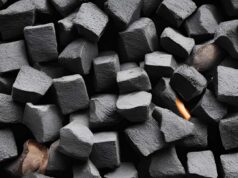- Key Takeaways:
- Mastering BBQ Butchering Techniques: A Beginner's Guide
- Understanding BBQ Butchering
- Choosing the Right Cuts of Meat
- Essential Tools for BBQ Butchering
- Preparation Techniques for BBQ Butchering
- Mastering Cooking Techniques
- Overcoming Common Butchering Challenges
- Serving and Presentation
- Frequently Asked Questions
- Frequently Asked Questions
Are you prepared to elevate your BBQ skills? Understanding BBQ butchering techniques is crucial for anyone aiming to serve mouthwatering, perfectly cooked meats.
This beginner’s guide outlines the fundamentals, from selecting the right cuts of meat to mastering essential preparation and cooking techniques.
You will discover the tools necessary for success, learn how to tackle common challenges, and impress your guests with beautifully sliced and presented BBQ.
Engage with this guide and embark on your journey to becoming a BBQ butchering expert.
Key Takeaways:
- Choosing the right cuts of meat is crucial for successful BBQ butchering. Consider factors such as marbling and thickness when selecting meat for grilling or smoking.
- Having the right tools, from knives to cooking equipment, is essential for mastering BBQ butchering. Invest in quality tools to ensure precision and safety.
- Preparation and cooking techniques, such as trimming, marinating, and temperature control, are key to achieving tender and flavorful BBQ meat. Don’t be afraid to experiment and find what works best for your taste buds.
Mastering BBQ Butchering Techniques: A Beginner’s Guide
Mastering BBQ butchering techniques is an essential skill for anyone looking to elevate their barbecue game. This guide aims to provide you with the foundational knowledge needed to prepare, cut, and cook high-quality meats such as ribs and brisket.
With the growing popularity of grilling and smoking in various regions—especially in Nolensville, Tennessee, home to renowned pitmaster Pat Martin of Martin’s BBQ Joint—understanding the intricacies of meat preparation can greatly enhance the flavor and overall enjoyment of your barbecue experience.
This guide will cover everything from selecting the right cuts of meat to honing the cooking techniques that can make or break your meal.
Understanding BBQ Butchering
BBQ butchering is the specialized skill of preparing meat specifically for grilling and smoking. This process emphasizes enhancing both the flavor and texture of the meat through the application of proper techniques and precise cuts.
What is BBQ Butchering?
BBQ butchering refers to the specialized process of preparing meat for grilling or smoking, utilizing techniques that enhance both flavor and tenderness.
To achieve the ultimate barbecue experience, you must begin by carefully selecting the right cuts of meat, as different types lend themselves to various cooking methods and flavor profiles.

Once you have chosen the meat, trimming excess fat becomes crucial; this not only helps reduce flare-ups during cooking but also ensures that the seasoning penetrates deeply, allowing for maximum flavor.
Deboning is another essential step, particularly when working with larger cuts like ribs or whole chickens, as it facilitates more even cooking and easier handling on the grill. Each of these steps is integral to ensuring that the meat is not only delicious but also cooked to perfection, ultimately setting the stage for a memorable cookout.
Importance of Butchering in BBQ
The significance of butchering in BBQ cannot be overstated, as it directly influences the flavor, texture, and overall quality of the final dish.
Effective butchering entails selecting the appropriate cuts and preparing them in ways that enhance the cooking process. For example, when working with brisket, skilled butchering can optimize heat distribution, allowing the meat to cook more evenly. Similarly, cuts like pork shoulder benefit considerably from expert trimming, which helps retain moisture during the lengthy cooking process, ensuring a juicy, tender result.
Additionally, creating a flavorful bark during the smoking phase relies heavily on how the meat is butchered, especially with ribs and tri-tips, where maximizing surface area is crucial for flavor absorption and crust formation.
Choosing the Right Cuts of Meat
Selecting the appropriate cuts of meat is essential for a successful BBQ. Different cuts provide distinct flavors, textures, and cooking requirements, all of which can significantly influence your overall experience.
Popular Cuts for BBQ
Some of the most popular cuts for BBQ include ribs, brisket, and chicken, each offering distinct flavors and culinary possibilities that can elevate any barbecue gathering.
When considering ribs, spare ribs and baby backs each bring a unique texture and taste to the table. Spare ribs, with their meatier sections and generous fat marbling, can be perfectly complemented by a dry rub or a tangy sauce. In contrast, baby backs, known for their tender and lean characteristics, often shine with a simple seasoning.
Brisket, particularly the packer cut, flat, and point, provides a range of succulent flavors depending on the cooking method used. The packer cut is ideal for serving large groups, while the flat is recognized for its uniform slices. To achieve the most flavor, it is essential to choose high-quality meat with a good amount of marbling, as this fat renders during cooking, enhancing both tenderness and taste. A careful selection of meat ensures that the barbecue experience is truly memorable.
Factors to Consider When Selecting Meat
When selecting meat for BBQ, several factors should be considered, including the meat’s marbling, quality, and how the cut will influence cooking time and flavor profile.
Choosing high-quality meat involves more than just assessing its appearance; it requires an understanding of specific characteristics that enhance the overall grilling experience. For example, marbling—the small streaks of fat within the muscle—plays a vital role in delivering flavor and tenderness during cooking, especially at high temperatures. Freshness is equally crucial; the meat should display a bright, vibrant color and minimal odor, indicating that it has been freshly processed rather than sitting on the shelf for an extended period.
Sourcing from reputable suppliers who prioritize ethical farming practices can significantly affect the meat’s flavor and quality, leading to a richer outcome when seared on the BBQ. Ultimately, these criteria intertwine to determine not only the taste of the final dish but also its juiciness and texture, leaving a lasting impression on those gathered around the grill.
Essential Tools for BBQ Butchering
Utilizing the right tools is essential for BBQ butchering, as they enable you to make precise cuts and ensure that the meat is prepared and cooked to perfection.
Knives and Cutting Tools
The right knives and cutting tools are essential for effective BBQ butchering, enabling you to make clean, precise cuts that enhance the meat’s flavor and texture.
Selecting the appropriate tools can significantly impact the final outcome, making it crucial for you to understand the variety of knives available. A sturdy chef’s knife is critical for general preparation tasks, allowing you to chop herbs and trim excess fat efficiently.
For separating meat from the bone, a boning knife with its thin, flexible blade is ideal, as it is vital for achieving tender cuts. When working with larger cuts of meat, a cleaver proves invaluable, enabling you to slice through tougher sections with ease.
Equally important is the maintenance of these tools; regularly honing the blades and keeping them clean will ensure they perform at their best, resulting in the highest quality cuts every time.
Equipment for Preparation and Cooking
Plus knives, having the appropriate equipment for preparation and cooking is essential for achieving optimal results in BBQ butchering.
Barbecue enthusiasts often utilize a variety of tools that can significantly enhance their grilling experience. For example, the choice between a charcoal grill and a gas grill can affect not only the cooking time but also the flavor infusion into the meat.
Smokers, whether electric or wood-fired, are crucial for those who enjoy slow-cooked, smoky dishes. Accessories such as chimney starters ensure that the charcoal is evenly ignited, while durable oven mitts help prevent burns during the cooking process.
Investing in high-quality equipment can elevate a simple gathering into a flavorful feast, improving both cooking efficiency and the overall taste of the barbecue.
Preparation Techniques for BBQ Butchering
Preparation techniques in BBQ butchering, such as trimming, marinating, and seasoning, are crucial for enhancing the flavor and tenderness of the meat.
Implementing these techniques will contribute to a more enjoyable dining experience.
Trimming and Deboning
Trimming and deboning are essential techniques in BBQ butchering that significantly enhance the flavor of the meat and ensure even cooking, thereby contributing to the overall quality of the barbecue.
By meticulously removing excess fat from cuts of meat, you can prevent the barbecue from becoming overly greasy, allowing the natural flavors to shine through. Deboning also facilitates a more uniform cooking experience, as bone-in meats can result in uneven heat distribution. When performing these processes, it is crucial to use a sharp knife and work with precision to ensure that only unwanted fat and bones are removed.
A practical tip is to trim fat while being mindful of the marbling, as some intramuscular fat can actually enhance flavor and tenderness. Adhering to these techniques not only improves the taste of the barbecue but also elevates the presentation, making each dish visually appealing.
Marinating and Seasoning
Marinating and seasoning are critical steps in BBQ butchering that can significantly enhance the flavor profile of the meat, leading to a deliciously smoky and savory outcome. These techniques are essential for transforming ordinary cuts into tantalizing culinary delights.
When you marinate, ingredients like apple cider vinegar not only infuse the meat with tangy undertones but also help break down tough fibers, resulting in a more tender bite. The artful use of rubs, which often combine spices and herbs, adds layers of flavor while creating a beautiful crust when grilled or smoked.
Through these methods, the natural juices of the meat are enhanced, ensuring that each bite is bursting with deliciousness, making the overall BBQ experience one that lingers in the memory.
Mastering Cooking Techniques
Mastering cooking techniques is essential for achieving BBQ perfection. Whether you choose to smoke or grill your meat, each method requires distinct approaches to flavor development and temperature control.
Smoking vs. Grilling: Key Differences
Smoking and grilling are two essential techniques in BBQ that provide distinct flavor profiles and cooking experiences, each with its own methods and best practices.
Grilling typically involves using high, direct heat to cook food quickly over flames, while smoking relies on low, indirect heat for an extended period. This allows the wood to infuse a rich, smoky flavor into the meat. Generally, grilling can take anywhere from a few minutes to an hour, depending on the thickness of the cuts, whereas smoking may extend over several hours or even a full day.
The choice of wood plays a significant role in determining flavor, with hickory imparting a robust, bold taste and cherry offering a subtly sweet, fruity note. Understanding these essential differences will not only enhance your culinary skills but also deepen your appreciation for the artistry involved in both methods.
Temperature Control and Timing
Temperature control and timing are crucial components of BBQ cooking, ensuring that you cook meat to perfection while retaining its juiciness and flavor.
Utilizing a meat thermometer is essential in this process, as it allows you to accurately monitor the internal temperature of the meat without having to cut into it. This technique not only preserves the moisture within the meat but also enhances the overall texture of your dish. Different cuts of meat have unique ideal temperatures for optimal taste. For instance:
- Steaks are best enjoyed at medium-rare, around 135°F.
- Chicken should reach a safe 165°F to prevent any health risks.
Understanding these specifics can help guarantee that each BBQ session results in deliciously tender and flavorful outcomes.
Overcoming Common Butchering Challenges
Overcoming common butchering challenges is essential for any aspiring BBQ enthusiast. Understanding how to handle tough cuts and prevent cross-contamination can significantly enhance your cooking skills.
Dealing with Tough Cuts
Dealing with tough cuts of meat in BBQ requires specific techniques that can transform them into tender, flavorful dishes, making them just as enjoyable as more tender options.
By employing methods such as slow cooking, marinating, and using expertly crafted BBQ rubs, you can effectively break down the fibrous texture of these cuts. Slow cooking, for instance, allows the meat to simmer in its juices, leading to a breakdown of the connective tissues, resulting in a melt-in-your-mouth experience. Additionally, marinating with acidic ingredients not only adds depth of flavor but also assists in tenderization, while BBQ rubs can further enhance the overall taste profile.
Gaining a thorough understanding of these techniques is essential, as it equips you with the skills needed to achieve superior results, even with those less desirable and often overlooked cuts of meat.
Preventing Cross-Contamination
Preventing cross-contamination is a critical aspect of BBQ safety, ensuring that raw meat does not come into contact with cooked foods or surfaces, which can lead to foodborne illnesses.
To create a safe cooking environment, it is essential to adopt a few simple yet effective cleanliness practices.
- Begin by separating your utensils and cutting boards; designate specific ones for raw meats and others for fresh vegetables and cooked items.
- Washing your hands thoroughly with soap and warm water before and after handling food is a necessary step that should never be overlooked.
- It is also advisable to keep surfaces sanitized and to use separate plates when transporting raw and cooked foods.
- Remember to cook foods to the proper internal temperatures, as this not only enhances flavor but also kills harmful bacteria, ensuring that every BBQ is both delicious and safe.
Serving and Presentation
Serving and presentation in BBQ are equally important as the cooking process itself. How you slice and serve your meat can significantly enhance the dining experience and effectively showcase the flavors of your hard work.
How to Slice and Serve BBQ Meat
Slicing and serving BBQ meat correctly is essential for maintaining its texture and flavor, ensuring that each bite is as enjoyable as the last.
Understanding the direction of the grain is crucial; cutting against the grain will result in more tender pieces, while slicing with the grain may yield tougher, chewier bites. Regarding thickness, aim for slices that are about a quarter-inch to a half-inch thick, striking the right balance between manageability and juiciness.
For serving, consider arranging the meat on a large platter accompanied by a variety of colorful sides such as pickles, coleslaw, and barbecue sauce. This enhances the presentation, making it eye-catching and inviting for your guests. Adding fresh herbs as a garnish can further elevate the dish and complement the rich flavors of the meat.
Pairing BBQ with Sides and Sauces
Pairing BBQ with the appropriate sides and sauces can significantly enhance the overall flavor experience, creating a memorable meal that beautifully complements the rich tastes of smoked and grilled meats.
Baked beans are an excellent choice to accompany barbecue, offering a sweet and savory contrast enriched by hints of molasses or brown sugar. Cornbread also pairs wonderfully, with its fluffy texture and slight sweetness balancing the smoky flavors. Coleslaw introduces a refreshing crunch that effectively cleanses the palate.
To elevate your culinary experience further, consider drizzling the meat with tangy barbecue sauces, such as vinegar-based or mustard sauces. These options highlight the deep, smoky notes and add layers of flavor. When combined, these accompaniments ensure that each bite of BBQ is even more delightful.
Frequently Asked Questions
This section addresses frequently asked questions about BBQ butchering techniques, offering valuable tips and insights for both beginners and experienced enthusiasts.
Frequently Asked Questions
1. What is BBQ butchering and why is it important?
BBQ butchering is the process of breaking down and preparing meat specifically for barbecuing. It is important because proper butchering techniques can enhance the flavor and tenderness of the meat, resulting in a more delicious BBQ experience.
2. Do I need any special tools or equipment for BBQ butchering?
While having certain tools such as a sharp knife and a meat thermometer can make the job easier, they are not necessary. As long as you have a basic understanding of the different cuts of meat and proper techniques, you can successfully master BBQ butchering without any special equipment.
3. What are some popular cuts of meat for BBQ and how should I butcher them?
Some popular cuts of meat for BBQ include ribs, brisket, pork shoulder, and chicken. For ribs, you will want to remove the membrane and trim any excess fat. For brisket, it is important to remove the silver skin and fat cap. Pork shoulder should be trimmed of any excess fat and chicken can be butterflied or spatchcocked for even cooking.
4. How can I tell if the meat is done and ready to be taken off the grill?
The best way to determine if the meat is done is by using a meat thermometer. Different types of meat have different recommended internal temperatures, so make sure to research and use the proper temperature for each cut. Additionally, you can use visual cues such as the color and texture of the meat to determine its doneness.
5. Are there any safety precautions I should take while BBQ butchering?
Yes, it is important to practice safe food handling and preparation when BBQ butchering. Make sure to wash your hands before and after handling raw meat, use separate cutting boards for meat and vegetables, and keep the meat refrigerated until you are ready to cook it.
6. What are some tips for beginners to successfully master BBQ butchering?
Start with simple cuts of meat and practice your technique before moving on to more challenging cuts. Research and familiarize yourself with the different cuts of meat and their recommended cooking methods. Additionally, don’t be afraid to experiment and try new things – BBQ butchering is all about finding what works best for you and your taste preferences.



